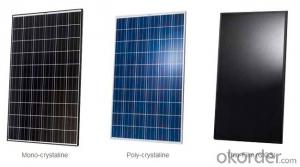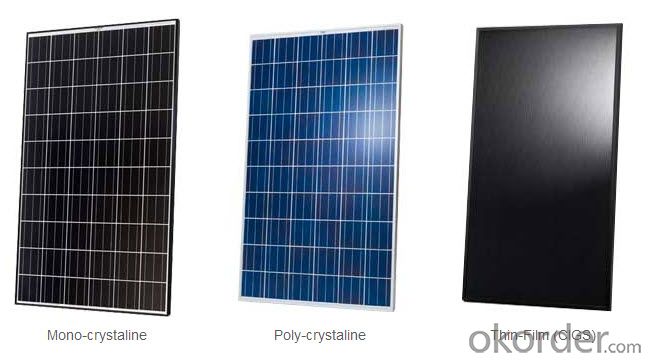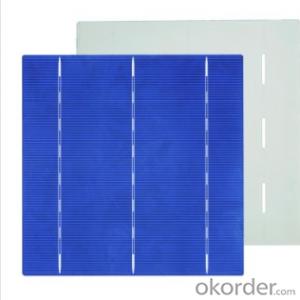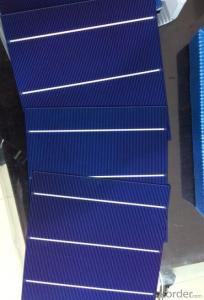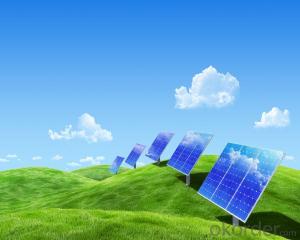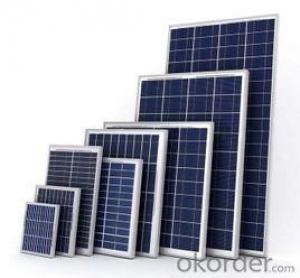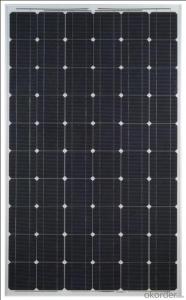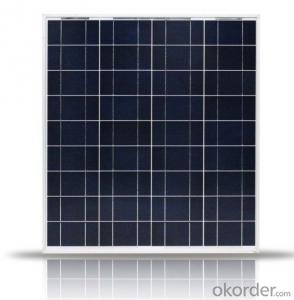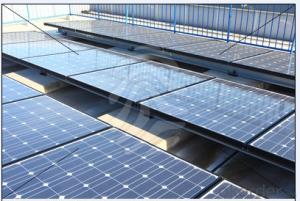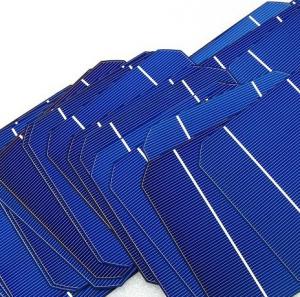240w Organic Dye Solar Panel with 25 Years Warranty CNBM
- Loading Port:
- Qingdao
- Payment Terms:
- TT OR LC
- Min Order Qty:
- 10 set
- Supply Capability:
- 300000 set/month
OKorder Service Pledge
OKorder Financial Service
You Might Also Like
Polycrystalline Solar Modules
CNBM offers a range of small, medium and large polycrystalline solar modules, designed for a range of requirements.
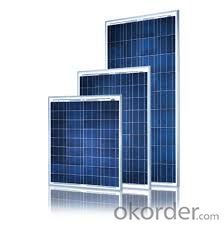

Specifications:
Tolerance | +/-3% |
Cell | Polycrystalline silicon solar cells (156 x 156mm) |
N0. of Cells | 60 (10 x 6) |
Dimension of Modules (mm) | 1650 x 990 x 40 |
Weight (kg) | 25.5 |
Limits:
Operating Temperature | -40~+85? |
Storage Temperature | -40~+85? |
Maximum System Voltage | 1000 VDC max. |
Hail Impact | Diameter of 28mm with impact speed |
Temperature and Coefficients:
NOCT | 48C+/-2? |
Voltage temperature coefficient (%/K) | -0.35 |
Current temperature coefficient (%/K) | 0.05 |
Power temperature coefficient (%/K) | -0.45 |
Characteristics:
Model: | SGM-200P | SGM-210P | SGM-220P |
Max-power voltage Vmp (V) | 29.2 | 29.4 | 29.41 |
Max-power current Imp (A) | 6.85 | 7.14 | 7.48 |
Open-circuit voltage Voc (V) | 36.5 | 36.69 | 36.9 |
Short-Circuit Current Isc (A) | 7.28 | 7.6 | 7.93 |
Max-power Pm(W) | 200 | 210 | 220 |
Model: | SGM-230P |
Max-power voltage Vmp (V) | 29.8 |
Max-power current Imp (A) | 7.72 |
Open-circuit voltage Voc (V) | 37.31 |
Short-Circuit Current Isc (A) | 8.19 |
Max-power Pm(W) | 230 |
STC: Irradiance 1000W/m2, module temperature 25?, AM-=1.5
Poly Crystalline Solar Panels Specifications Range
Maximum Power (Pm) | Dimension | Weight | Operating Voltage (Vmp) | Operating Current (Imp) | Open Circuit Voltage (Voc) | Short Circuit Current (Isc) |
0.45W | 140x80x10mm | 0.08kg | 3.3V | 150mA | 4.6V | 160mA |
1.0W | 162x140x10mm | 0.16kg | 7.5V | 150mA | 10.3V | 160mA |
4.5W | 269x251x23mm | 0.8kg | 16.5V | 0.27A | 20.5V | 0.3A |
10W | 420.1×268.9×22.6mm | 1.92kg | 17.5V | 0.58A | 20.5V | 0.6A |
20W | 425x502x50mm | 3.0kg | 16.8V | 1.19A | 21.0V | 1.29A |
30W | 593x502x22.6mm | 3.9kg | 16.8V | 1.78A | 21.0V | 1.94A |
40W | 655x537x50mm | 5.75kg | 17.3V | 2.31A | 22.1V | 2.54A |
50W | 839x537x50mm | 6.0kg | 17.5V | 2.9A | 21.8V | 3.17A |
65W | 1111x502x50mm | 7.2kg | 17.6V | 3.69A | 22.1V | 3.99A |
80W | 1204x537x50mm | 7.7kg | 17.6V | 4.55A | 22.1V | 4.8A |
- Q: Have you ever been to a solar cell power generation station?
- We have a big solar cell power generation station nearby.
- Q: How do solar cells perform in areas with high humidity?
- Solar cells generally perform slightly less efficiently in areas with high humidity. The moisture in the air can create a barrier between the sunlight and the solar cells, reducing their ability to convert sunlight into electricity. However, advancements in solar cell technology have improved their performance in high humidity conditions, making them still viable and effective in such areas.
- Q: What is the impact of shadows on solar cell performance?
- Shadows have a negative impact on solar cell performance as they decrease the amount of sunlight reaching the solar panel, therefore reducing the electricity generation. Shadows can create "hot spots" on the cells, leading to higher temperatures and potential damage. It is essential to ensure that solar panels are installed in areas free from shadows to maximize their efficiency and overall performance.
- Q: Can solar cells be used in theme parks or amusement parks?
- Yes, solar cells can be used in theme parks or amusement parks. Solar panels can be installed on rooftops, parking structures, or open areas within the park to generate renewable energy. This energy can be used to power rides, lighting, and other facilities, reducing reliance on traditional electricity sources and lowering operating costs. Additionally, incorporating solar technology aligns with the sustainable and eco-friendly image that many theme parks strive to promote.
- Q: How much energy can a solar cell generate?
- The amount of energy a solar cell can generate depends on various factors such as its size, efficiency, and the available sunlight. On average, a standard solar cell can generate around 200 to 400 watts of electricity per square meter in optimal conditions. However, technological advancements continue to improve the efficiency of solar cells, allowing for higher energy generation in the future.
- Q: Can solar cells be used in railway applications?
- Yes, solar cells can be used in railway applications. They can be installed on train rooftops to generate electricity, which can power various systems such as lighting, air conditioning, and communication systems. This helps reduce reliance on traditional power sources, lower operating costs, and make railways more sustainable and environmentally friendly.
- Q: What is the largest solar cell installation in the world?
- The largest solar cell installation in the world is the Tengger Desert Solar Park in China, with a capacity of 1.5 gigawatts.
- Q: Are solar cells environmentally friendly?
- Yes, solar cells are environmentally friendly. They generate electricity by harnessing the sun's energy, which is a clean and renewable source of power. Solar energy production does not produce greenhouse gas emissions, air pollution, or create hazardous waste. Additionally, solar cells have a long lifespan and can be recycled at the end of their life, minimizing their environmental impact.
- Q: Can solar cells be used for powering agricultural irrigation systems?
- Yes, solar cells can be used for powering agricultural irrigation systems. Solar-powered irrigation systems use photovoltaic cells to convert sunlight into electricity, which can then be used to power pumps and other equipment needed for irrigation. This sustainable and renewable energy source is particularly beneficial for remote areas with limited access to electricity grids.
- Q: How is the solar cells factories working in China? Do they follow certain quality standards?
- I know many good solar cell suppliers all over the world, and they are purchasing their solar cells product in China more and more.
Send your message to us
240w Organic Dye Solar Panel with 25 Years Warranty CNBM
- Loading Port:
- Qingdao
- Payment Terms:
- TT OR LC
- Min Order Qty:
- 10 set
- Supply Capability:
- 300000 set/month
OKorder Service Pledge
OKorder Financial Service
Similar products
Hot products
Hot Searches
Related keywords
